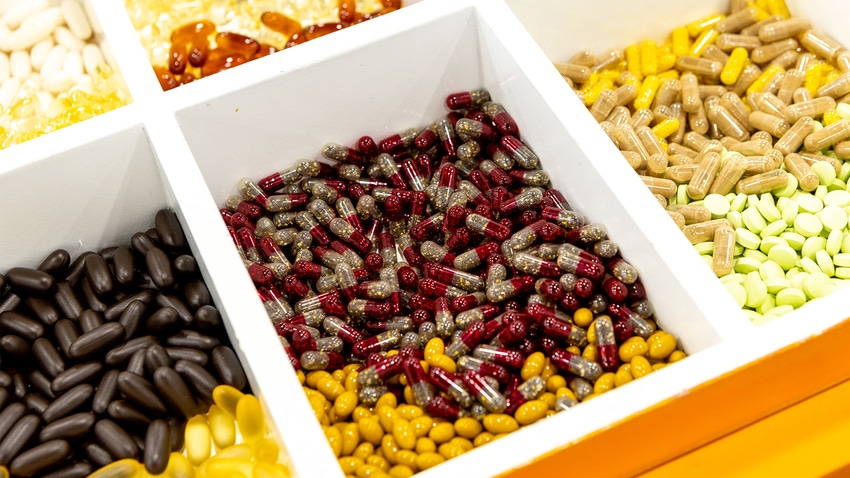From supplement to supermarket: These SupplySide West standouts are fit for F&B formulation
SupplySide West showcased standout ingredients driving innovation in the supplement sector, and experts believe these ingredients can transition from supplements to mainstream foods and beverages.

At a Glance
- F&B brands can take advantage of some of the hottest supplement ingredients to create innovative and relevant products.
- Standout ingredients include polyphenols, beta-alanine, berberine and cucumber extract.
- These ingredients can be used to create a variety of products, including beverages, protein bars, gummies and baked goods.
SupplySide West is such a big bash for the supplement sector that food and beverage brands can be forgiven for feeling a twinge of fear of missing out (FOMO) following the festivities.
And it only takes a quick scan of the coverage—including this Natural Products Insider report on 12 star ingredients spied on the expo floor—to see why: Sexy standouts like berberine, beta-alanine and “natural” caffeine stole the show for sparking innovation in some of the strongest supplement segments thriving today.
But with the boundary between supplements and functional foods blurring by the quarter, there’s no reason these ingredients can’t fuel food and beverage formulation, too.
Compelling and relevant
That’s certainly what Kantha Shelke, Ph.D., CFS, principal at Corvus Blue LLC, believes. And for her money, the ingredients best situated to shift from supplements to supermarkets are those that demonstrate relevance.
“Resonating with the audience’s needs, lifestyles and routines will elevate these ingredients’ public perceptions and further their evolution into daily use foods and beverages,” she said. And if consumers feel a “palpable effect” from the ingredients, the more the better.
Consumers, however, are only half the equation. “These materials should appeal to product developers and marketers in the food industry first,” Shelke explained. “That requires a science-based communications piece that explains their value without the hype of dietary supplements.”
Clear communication
For example, when Shelke evaluated those 12 standout ingredients for her favorites, she gravitated toward BGG World’s ApplePhenon polyphenols, Carnosyn beta-alanine by Natural Alternatives International, Ningbo Herb’s Berberine HCl and Cuvitus cucumber extract from Xsto Solutions. Why? They get straight to the point.
As Shelke puts it, “If a wellness ingredient wants to gain trust and understanding, then it should be transparent in its name and science-based taglines about what it is, what it’s sourced from and what it does. My choices here are somewhat clear about what they are, their source and their functionality.”
And they’re not over-the-top in their claims. “For example, ‘empowering women’ is not a health benefit that one would expect from a dietary supplement,” Shelke said. “So until supplement ingredient suppliers shed the language of performance-enhancement materials, it’ll be difficult for them to be accepted by food product developers for mainstream foods.”
Exciting opportunities
Rachel Zemser, CFS, CCS, MS, product development consultant and founder of A La Carte Connections, takes a different tack in choosing which show standouts she’d like to see in foods and beverages—underscoring the opportunities they provide to address “hot” concerns like energy, sleep, weight loss and women’s health.
For example, Zemser actually appreciates the “women-power” message behind Gencor’s Libifem, a standardized fenugreek extract that made waves in Las Vegas. Noting that fenugreek has long “played an important role in stimulating milk production in lactating women,” she points to current research supporting its “bonus benefits” around reducing hot flashes and improving sexual health. “Bake it into cookies or add it to protein shakes and nutritional bars,” she said. “Or use it as an extract in delivery formats like shots and gummies.”
Zemser also sees potential in CAIF Nutrition’s natural caffeine. After all, “Everyone from gamers to exercise enthusiasts to tired moms leans on caffeine for energy,” she said. “But not everyone wants to drink a cup of coffee or a shady energy shot to get it.” Enter “natural” caffeine, which, blended into a protein bar or shake, can help consumers “double up on their protein and caffeine at the same time,” she noted.
Getting Zzzs
“But just like we need our caffeine, we also need our sleep, and melatonin is a great non-addictive alternative to sleeping pills,” Zemser said. That’s why she’s bullish on Somato, NutraLand USA’s whole-food melatonin derived from tomato. Applauding its plant-based sourcing and lycopene, Zemser sees it as a natural fit for popular formats like gummies.
Zeroing in on the gut-immune axis, she gives her next thumbs-up to Immuolin by Entera Health, a serum-derived bovine immunoglobulin protein isolate that functions as a postbiotic. Postbiotics, as she says, “are all the rage now,” largely due to the inherent heat stability that suits them to a range of applications unavailable to live probiotics. “And because you don’t need to include much in a baked good to get the full benefits, low use levels equal lower costs,” Zemser said.
Common ground
Zemser also thinks the time is ripe for a responsibly sourced, vegetarian-friendly form of docosahexaenoic acid (DHA) and eicosapentaenoic acid (EPA) omega-3s. GC Rieber’s Vivo Mega, an algal option, checks those boxes. “Omega-3s are important for health, but with the kind from fish becoming unsustainable, this is a great alternative,” she said. Even better, all it needs is an emulsifier to keep it suspended in beverages.
Finally, Zemser shares Shelke’s enthusiasm for Berberine HCl. “With obesity on the rise and elevated blood sugar causing big health concerns, this product works like a ‘natural Ozempic’ to reduce blood sugar and promote weight loss,” she said. While it’s off-limits to pregnant consumers and requires delicate handling—“it can cause some nausea”—she could certainly imagine it in edible applications like the ubiquitous gummy.
About the Author(s)
You May Also Like






